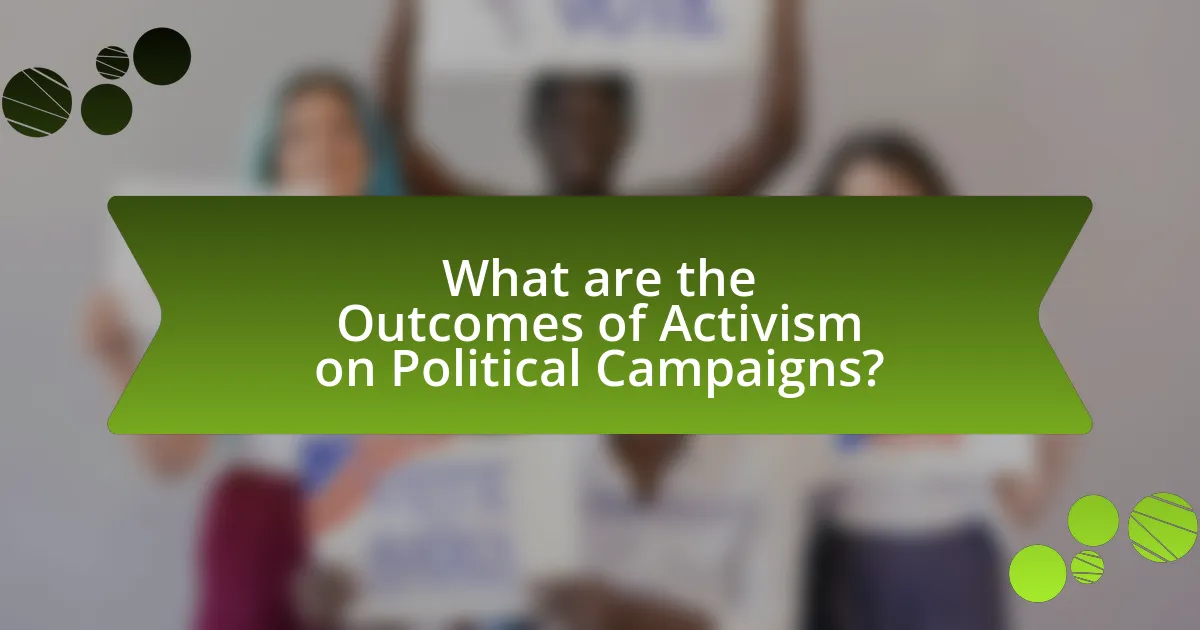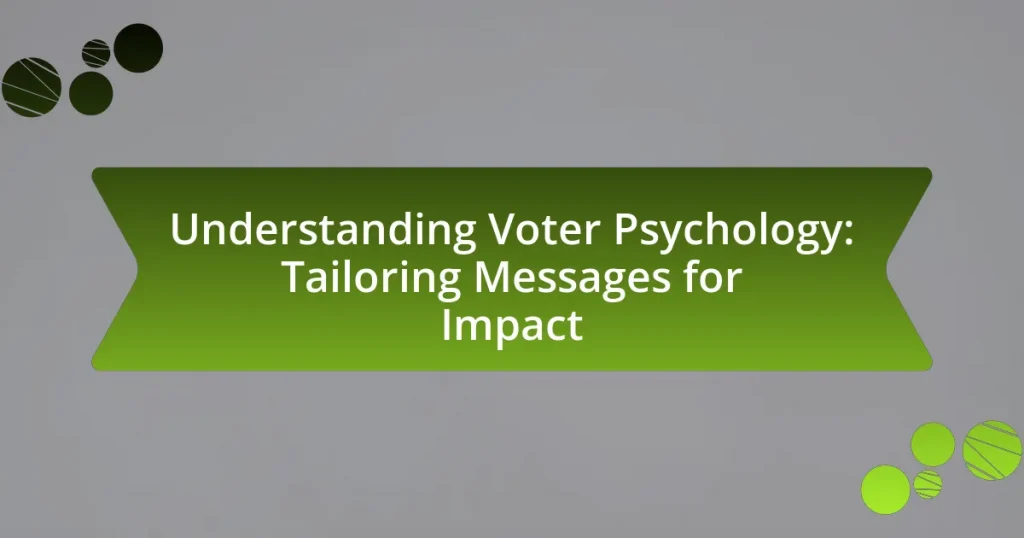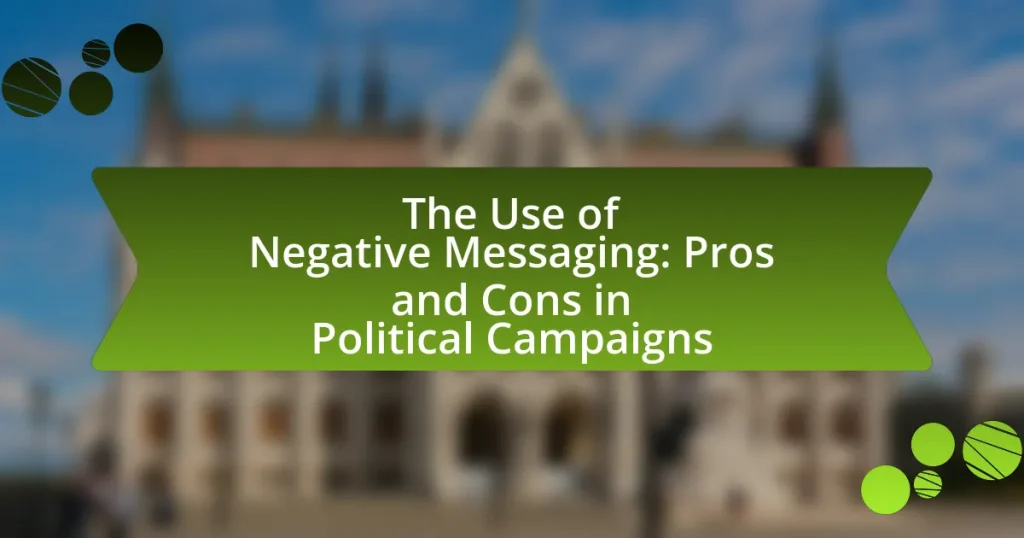Messaging for Change in political campaigns refers to strategic communication efforts aimed at influencing public opinion and mobilizing support for social or political issues, often driven by grassroots activism. The article explores how activism shapes political messaging, highlighting key elements of effective activist messaging, the role of different movements in framing political narratives, and the importance of messaging in voter engagement and election outcomes. It also examines the tactics used by activists to influence political campaigns, the challenges they face, and the ways in which political candidates leverage activist support to enhance their platforms. Ultimately, the article underscores the significant impact of activism on political campaigns and policy changes, providing insights into best practices for both activists and candidates in integrating messaging effectively.

What is Messaging for Change in Political Campaigns?
Messaging for Change in political campaigns refers to the strategic communication efforts aimed at influencing public opinion and mobilizing support for specific social or political issues. This approach often leverages grassroots activism, utilizing narratives and messaging that resonate with the values and concerns of the electorate. For example, campaigns that focus on climate change or social justice often employ messaging that highlights personal stories and community impacts to create emotional connections and drive engagement. Research indicates that effective messaging can significantly enhance voter turnout and support for candidates aligned with progressive causes, demonstrating the power of targeted communication in shaping political landscapes.
How does activism influence political messaging?
Activism significantly influences political messaging by shaping the narratives and priorities that political campaigns adopt. Activists often highlight specific social issues, mobilizing public opinion and pressuring politicians to address these concerns, which in turn alters the language and themes used in political messaging. For instance, the Black Lives Matter movement has prompted political candidates to incorporate discussions on racial justice and police reform into their platforms, reflecting the urgency and importance of these topics as articulated by activists. This influence is evidenced by the increased use of terms like “systemic racism” and “defunding the police” in political discourse following widespread protests, demonstrating how activism can directly impact the framing of political messages and campaign strategies.
What are the key elements of effective activist messaging?
The key elements of effective activist messaging include clarity, emotional appeal, a strong call to action, and audience targeting. Clarity ensures that the message is easily understood, which is crucial for mobilizing support; for instance, the Women’s March utilized straightforward slogans to convey their goals. Emotional appeal engages the audience on a personal level, as seen in campaigns like “Black Lives Matter,” which evoke strong feelings about social justice. A strong call to action motivates individuals to participate or support the cause, exemplified by the “Ice Bucket Challenge,” which encouraged donations for ALS research. Finally, audience targeting tailors the message to specific demographics, enhancing relevance and impact, as demonstrated by environmental campaigns that focus on local issues to resonate with community members.
How do different activist movements shape political narratives?
Different activist movements shape political narratives by influencing public discourse, mobilizing support, and framing issues in ways that resonate with broader societal values. For instance, the Civil Rights Movement in the 1960s redefined the narrative around racial equality in the United States, leading to significant legislative changes such as the Civil Rights Act of 1964. Similarly, the LGBTQ+ rights movement has shifted societal perceptions and policies regarding same-sex marriage, culminating in the Supreme Court’s decision in Obergefell v. Hodges in 2015, which legalized same-sex marriage nationwide. These movements utilize strategic messaging, grassroots organizing, and media engagement to challenge existing narratives and promote new frameworks that align with their goals, thereby reshaping political landscapes and influencing policy outcomes.
Why is messaging crucial for political campaigns?
Messaging is crucial for political campaigns because it shapes public perception and influences voter behavior. Effective messaging communicates a candidate’s values, policies, and vision, allowing voters to connect emotionally and intellectually with the campaign. Research indicates that campaigns with clear and consistent messaging can increase voter engagement and turnout; for instance, a study by the Pew Research Center found that 70% of voters are influenced by campaign messages that resonate with their personal beliefs and experiences. This demonstrates that strategic messaging not only informs but also mobilizes supporters, making it a fundamental component of successful political campaigns.
What role does messaging play in voter engagement?
Messaging plays a crucial role in voter engagement by shaping perceptions, mobilizing support, and influencing decision-making. Effective messaging communicates key issues, resonates with voters’ values, and fosters a sense of urgency, which can significantly increase voter turnout. For instance, studies have shown that targeted messaging can lead to a 10-20% increase in voter participation, particularly among underrepresented demographics. This demonstrates that well-crafted messages not only inform but also motivate individuals to engage in the electoral process.
How can messaging impact election outcomes?
Messaging can significantly impact election outcomes by shaping voter perceptions and influencing their decisions. Effective messaging can highlight key issues, resonate with target demographics, and mobilize supporters. For instance, during the 2008 U.S. presidential election, Barack Obama’s campaign utilized messaging strategies that emphasized hope and change, which contributed to his victory by appealing to a broad coalition of voters. Research indicates that campaigns that effectively communicate their messages can increase voter turnout by as much as 5% to 10%, demonstrating the direct correlation between messaging and electoral success.

How do Activist Movements Shape Political Campaigns?
Activist movements shape political campaigns by influencing public opinion, mobilizing voters, and setting the agenda for political discourse. These movements often bring attention to specific issues, such as climate change or social justice, which candidates then incorporate into their platforms to resonate with constituents. For example, the Black Lives Matter movement has significantly impacted political campaigns by prompting candidates to address systemic racism and police reform, leading to policy proposals that reflect these concerns. Additionally, research shows that campaigns that align with activist movements can see increased voter engagement and turnout, as seen in the 2020 U.S. elections where issues raised by activists were pivotal in driving participation among younger voters.
What strategies do activists use to influence political messaging?
Activists use various strategies to influence political messaging, including grassroots mobilization, social media campaigns, and coalition-building. Grassroots mobilization involves organizing community members to advocate for specific issues, which can amplify their voices and pressure political leaders. Social media campaigns leverage platforms like Twitter and Facebook to disseminate messages rapidly, engage a wider audience, and create viral content that captures public attention. Coalition-building brings together diverse groups to unify efforts and strengthen the impact of their messaging, as seen in movements like Black Lives Matter, which effectively combined various organizations to address systemic racism. These strategies have been proven effective in shaping public discourse and influencing policy decisions, as evidenced by the significant shifts in political messaging surrounding climate change and social justice in recent years.
How do social media platforms amplify activist messages?
Social media platforms amplify activist messages by providing a vast and immediate reach to diverse audiences. These platforms enable activists to share information rapidly, mobilize supporters, and create viral content that can influence public opinion and policy. For instance, during the Black Lives Matter movement, hashtags like #BlackLivesMatter gained millions of impressions, facilitating global conversations and awareness about racial injustice. Additionally, algorithms on platforms such as Twitter and Facebook prioritize engaging content, allowing activist messages to spread quickly and widely, often reaching individuals who may not have been previously aware of the issues. This capacity for rapid dissemination and engagement is supported by statistics showing that social media campaigns can increase participation in protests and advocacy efforts significantly, demonstrating their effectiveness in amplifying activist voices.
What are the challenges activists face in getting their messages heard?
Activists face significant challenges in getting their messages heard, primarily due to media saturation and misinformation. The overwhelming amount of information available in today’s digital landscape makes it difficult for activists to capture public attention. Additionally, misinformation can distort their messages, leading to public confusion and skepticism. According to a 2021 Pew Research Center study, 64% of Americans believe that misinformation has a major impact on their understanding of current events, which directly affects how activist messages are perceived. Furthermore, activists often encounter institutional barriers, such as limited access to mainstream media platforms, which can hinder their ability to disseminate their messages effectively.
How do political campaigns respond to activist messaging?
Political campaigns respond to activist messaging by adapting their strategies to align with the values and demands expressed by activists. This alignment often includes incorporating key issues raised by activists into campaign platforms, adjusting messaging to resonate with activist audiences, and sometimes collaborating with activist groups to enhance credibility and outreach. For instance, during the 2020 U.S. presidential election, candidates like Joe Biden integrated climate change and racial justice into their platforms, reflecting the priorities of activist movements such as the Sunrise Movement and Black Lives Matter. This responsiveness not only helps campaigns to mobilize support but also demonstrates an awareness of grassroots movements, which can significantly influence voter engagement and turnout.
What tactics do campaigns employ to align with activist causes?
Campaigns employ various tactics to align with activist causes, including strategic messaging, coalition-building, and grassroots mobilization. Strategic messaging involves crafting narratives that resonate with the values and goals of activist movements, ensuring that campaign platforms reflect the concerns of these groups. Coalition-building entails forming partnerships with established activist organizations to leverage their networks and credibility, enhancing the campaign’s reach and impact. Grassroots mobilization focuses on engaging community members through events, social media, and direct outreach, fostering a sense of collective action and urgency around the cause. These tactics are supported by research indicating that campaigns that effectively integrate activist perspectives can increase voter engagement and support, as seen in the 2020 U.S. elections where candidates who aligned with social justice movements saw significant voter turnout among younger demographics.
How can campaigns effectively integrate activist messages into their platforms?
Campaigns can effectively integrate activist messages into their platforms by aligning their core values with the goals of the activist movements they support. This alignment ensures authenticity and resonates with the target audience, as seen in the 2020 U.S. presidential campaigns where candidates like Bernie Sanders incorporated climate justice and social equity into their platforms, reflecting the priorities of grassroots movements. By actively engaging with activists, campaigns can gather insights and incorporate specific demands, such as the Green New Deal, which gained traction due to its alignment with environmental activism. This strategic integration not only enhances credibility but also mobilizes supporters who are passionate about these issues, ultimately driving voter engagement and participation.

What are the Outcomes of Activism on Political Campaigns?
Activism significantly influences political campaigns by mobilizing voter engagement, shaping public discourse, and impacting policy agendas. For instance, movements like Black Lives Matter have increased voter turnout among younger demographics, evidenced by a 2020 study from the U.S. Census Bureau showing a 50% increase in turnout among 18-29 year-olds compared to previous elections. Additionally, activism often shifts the narrative around key issues, compelling candidates to address topics such as climate change and social justice, as seen in the 2020 presidential campaign where candidates adopted progressive platforms in response to grassroots demands. Furthermore, successful activist campaigns can lead to the introduction of new legislation, as demonstrated by the advocacy for gun control following mass shootings, which has prompted candidates to prioritize this issue in their platforms.
How does activism lead to policy changes?
Activism leads to policy changes by mobilizing public opinion and influencing decision-makers. Activists raise awareness about specific issues, creating pressure on policymakers to respond to constituents’ demands. For example, the Civil Rights Movement in the 1960s utilized protests and advocacy to highlight racial injustices, resulting in landmark legislation like the Civil Rights Act of 1964. This demonstrates how sustained activism can shift societal norms and compel legislative action.
What examples illustrate successful activist-driven policy shifts?
Successful activist-driven policy shifts include the legalization of same-sex marriage in the United States and the implementation of the Clean Power Plan. The legalization of same-sex marriage was largely driven by grassroots activism, culminating in the Supreme Court’s 2015 decision in Obergefell v. Hodges, which recognized the constitutional right to marry for same-sex couples. This decision followed decades of advocacy, public demonstrations, and changing public opinion, illustrating how sustained activism can lead to significant legal and policy changes.
Similarly, the Clean Power Plan, introduced by the Obama administration in 2015, aimed to reduce carbon emissions from power plants and was influenced by environmental activism. This policy shift was a response to growing concerns about climate change and was supported by numerous environmental organizations that mobilized public support and lobbied for stronger regulations. Both examples demonstrate how organized activism can effectively shape and influence policy at the highest levels.
How do political candidates leverage activist support for their campaigns?
Political candidates leverage activist support by aligning their campaign messages with the goals and values of activist groups, thereby mobilizing grassroots efforts and enhancing voter engagement. This strategy often includes incorporating activist-driven issues into their platforms, which can attract dedicated supporters who are passionate about those causes. For instance, candidates may adopt policies related to climate change or social justice that resonate with environmental or civil rights activists, thus gaining credibility and visibility within those communities. Research indicates that candidates who actively engage with activists can increase their campaign reach and effectiveness, as seen in the 2020 U.S. elections where candidates who prioritized issues championed by activists saw higher turnout among those demographics.
What lessons can be learned from the intersection of activism and political campaigns?
The intersection of activism and political campaigns teaches that grassroots movements can significantly influence political agendas and voter engagement. Activism often mobilizes communities around specific issues, creating a sense of urgency that political campaigns can harness to resonate with voters. For instance, the Black Lives Matter movement has shaped discussions on racial justice in political platforms, demonstrating how sustained activism can lead to policy changes and increased voter turnout. Additionally, campaigns that align with activist causes tend to attract younger voters, as seen in the 2020 U.S. elections, where climate activism galvanized support for candidates prioritizing environmental policies. This synergy illustrates that effective political messaging often incorporates the narratives and demands of active social movements, leading to more impactful and relevant campaign strategies.
How can future campaigns better incorporate activist messaging?
Future campaigns can better incorporate activist messaging by aligning their core values with the specific social issues that resonate with their target audience. This alignment can be achieved through authentic storytelling that highlights real-life experiences and the impact of activism, thereby fostering a deeper emotional connection with constituents. For instance, campaigns that successfully integrated activist messaging, such as the 2018 midterm elections in the United States, saw increased voter engagement by addressing issues like climate change and social justice directly linked to grassroots movements. This approach not only amplifies the campaign’s message but also builds credibility and trust among voters, as evidenced by the significant turnout rates among younger demographics who prioritize these issues.
What best practices should activists follow when engaging with political campaigns?
Activists should prioritize clear messaging and strategic collaboration when engaging with political campaigns. Clear messaging ensures that the core values and goals of the activism resonate with the campaign’s objectives, enhancing the likelihood of alignment and support. Strategic collaboration involves building coalitions with like-minded organizations and stakeholders to amplify influence and reach. For instance, the Women’s March in 2017 effectively mobilized diverse groups by uniting under a common message of equality and justice, demonstrating the power of cohesive activism in political contexts.
What practical steps can activists take to enhance their messaging in political campaigns?
Activists can enhance their messaging in political campaigns by utilizing targeted communication strategies, leveraging social media platforms, and engaging in community outreach. Targeted communication involves identifying specific demographics and tailoring messages that resonate with their values and concerns, which can increase engagement and support. Social media platforms, such as Twitter and Facebook, allow activists to disseminate their messages widely and interact directly with constituents, fostering a sense of community and urgency. Community outreach, including town hall meetings and local events, enables activists to connect personally with voters, gather feedback, and adjust messaging based on real-time responses. These steps are supported by research indicating that personalized messaging and direct engagement significantly improve voter mobilization and campaign effectiveness.



